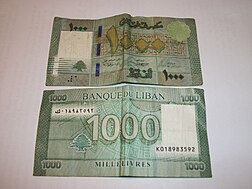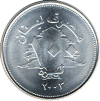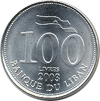Lebanese Pound
The pound or lira is the currency of Lebanon.
It was formerly divided into 100 piastres (or qirsh in Arabic) but, because of high inflation during the Lebanese Civil War (1975–1990), subunits were discontinued.
 LL 1,000 note, using Arabic on the obverse and French on the reverse | |
| ISO 4217 | |
| Code | LBP (numeric: 422) |
| Subunit | 0.01 |
| Symbol | None official. The abbreviation LL or ل.ل. is used |
| Denominations | |
| Subunit | |
| 1⁄100 | piastre |
| Banknotes | LL 1,000, LL 5,000, LL 10,000, LL 20,000, LL 50,000, LL 100,000 |
| Coins | LL 250, LL 500 |
| Demographics | |
| User(s) | |
| Issuance | |
| Central bank | Banque du Liban |
| Website | www |
| Valuation | |
| Inflation | 177.25% |
| Source | https://economics.creditlibanais.com/Article/212047#en |
| Pegged with | U.S. dollar note |
note Dual exchange rate system (Sayrafa) in effect as of June 2021 | |
The plural of lira is either lirat (ليرات līrāt) or invariant, whilst there are four forms for qirsh: the dual qirshān (قرشان) used with number 2, the plural qurush (قروش) used with numbers 3–10, the accusative singular qirshan (قرشًا) used with 11–99, and the genitive singular qirsh (قرش) used with multiples of 100. The number determines which plural form is used. All of Lebanon's coins and banknotes are bilingual in Arabic and French.
From December 1997 through January 2023, the exchange rate was fixed at LL 1,507.50 per US dollar. However, since the 2020 economic crisis in Lebanon, exchange at this rate was generally unavailable, and an informal currency market developed with much higher exchange rates. On 1 February 2023, the Central Bank reset the currency peg at LL 15,000 per US dollar. By mid-March 2023, the "parallel market" rate had fallen to LL 100,000 per dollar.
History
Until World War I, the Turkish pound was the currency used in the area. In 1918, after the fall of the Ottoman Empire, the Egyptian pound was used. Upon gaining control of Syria and Lebanon, the French replaced the Egyptian pound with a new currency for Syria and Lebanon, the Syrian pound, which was linked to the franc at a value of LS 1 = 20 F. Lebanon issued its own coins from 1924 and banknotes from 1950.[citation needed] In 1939, the Lebanese currency was officially separated from that of Syria, though it was still linked to the French franc and remained interchangeable with Syrian money. In 1941, following France's defeat by Nazi Germany, the currency was linked instead to sterling at a rate of LL 8.83 = GBP1.00 A link to the French franc was restored after the war, but was abandoned in 1949.
Before the third phase of the Lebanese Civil War, USD1 was worth:
- LL 3.07 in 1965
- LL 3.26 in 1970
- LL 2.25 in 1975
- about LL 4 in 1981
In 1986, the pound began falling against the dollar. On 13 June, a dollar was worth LL 36.50. Two weeks later, it was worth LL 47.
- LL 500 in 1987
- LL 900 in December 1989
During the Civil War, the currency depreciated rapidly until 1992, when one US dollar was worth over LL 2,500. Subsequently, the government attempted to peg the currency: from December 1997 until February 2023, the official rate was fixed at LL 1,507.50 = USD1.00
In August 2019, due to the increasing supply of Lebanese pounds in the economy, pressure on the fixed exchange rate with the US dollar started, creating a parallel market rate.[citation needed] In March 2021, the free market rate in Beirut was LL 10,000 = USD1.00 By July 2021, it was around LL 24,000 to the dollar. On 18 March 2023, the value of the Lebanese pound dropped in the free market to LL 111,000 against the US dollar, its lowest value ever.
On 10 May 2021, the Lebanese Central Bank (BDL) announced the launch of the "Sayrafa" platform, an electronic platform intended to record all Lebanese Pounds foreign exchange transactions and identify the exchange rates at any point in time. The platform was launched in June 2021 and became the official USD-to-lira exchange rate for all credit card transactions on 1 February 2022. In March 2023, the Sayrafa exchange rate became 43% less than the unofficial, free market rate.
Coins
Lebanon's first coins were issued in 1924 in denominations of 2 and 5 piastres (p). Later issues did not include the word "syriennes" and were in denominations of 1⁄2p, 1p, 2p, 2+1⁄2p, 5p, 10p, 25p and 50p. During World War II, rather crudely made 1⁄2p, 1p and 2+1⁄2p coins were issued. Before the war all coins were minted in Paris.
After the war, the Arabic spelling was changed from girsh (غرش) to qirsh (قرش). Coins were issued in the period 1952 to 1986 in denominations of 1p, 2+1⁄2p, 5p, 10p, 25p, 50p and LL 1. No coins were issued between 1986 and 1994, when the current series of coins was introduced.
Coins in current use are:
| Coins of the Lebanese pound | ||||||||
|---|---|---|---|---|---|---|---|---|
| Image | Value | Technical parameters | Colour | Date of issue | ||||
| Obverse | Reverse | Diameter | Thickness | Mass | Metal | |||
| Coins no longer in circulation | ||||||||
 |  | 5p | Aluminium-bronze | 1924 | ||||
 |  | 5p | Aluminium-bronze | 1925 1931 1933 1936 1940 | ||||
 |  | 50p | 10 g | Silver | 1929 1933 1938 | |||
 |  | 5p | 18 mm | 2.2 g | Copper-nickel-aluminium | Golden yellow | 1968 1969 1972 1975 | |
 |  | 10p | 21 mm | 3.2 g | Copper-nickel-aluminium | Golden yellow | 1968 1969 1970 1972 1975 | |
 |  | 25p | 23.5 mm | 4 g | Nickel-brass | Golden yellow | 1968 1969 1970 1972 1975 1980 | |
 |  | 50p | 24 mm | 6 g | Nickel | White nickel | 1968 1969 1970 1971 1975 1978 1980 | |
| LL 1 | 27.5 mm | 8 g | Nickel | White nickel | 1975 1977 1980 1981 | |||
| 27 mm | 7.22 g | Nickel-plated steel | White nickel | 1986 | ||||
| Coins in circulation | ||||||||
| LL 25 | 20.5 mm | 1.3 mm | 2.8 g | Nickel-plated steel | White nickel | 2002 | ||
 |  | LL 50 | 19 mm | 1.15 mm | 2.25 g | Stainless steel | White nickel | 1996 |
| LL 50 | 21.5 mm | 1.67 mm | 3g | Nickel-plated steel | 2006 | |||
 |  | LL 100 | 22.5 mm | 1.80 mm | 4 g | Zinc and copper | Red copper | 1995 1996 2000 |
 |  | LL 100 | 22.5 mm | 1.83 mm | 4 g | Steel and nickel | White | 2003 |
| LL 100 | 22.5 mm | 1.80 mm 1.60 mm | 4 g | Steel and copper | Red copper | 2006 2009 | ||
 |  | LL 250 | 23.5 mm | 1.82 mm | 5 g | Copper and aluminium | Yellow gold | 1995 1996 2000 2003 |
| 1.65 mm | Nordic Gold | Nordic Gold | 2006 2009 2012 | |||||
 |  | LL 500 | 24.5 mm | 2.05 mm | 6 g | Nickel-plated steel | White | 1995 1996 2000 2003 2006 2009 2012 |
| For table standards, see the coin specification table. | ||||||||
By January 2023,[citation needed] the only coins in use are the 250- and 500-pound ones. The other lower-value coins are worthless now due to hyperinflation.
Banknotes
This section needs expansion with: Obverse and Reverse presentations on the listed notes. You can help by adding to it. (September 2023) |

Lebanon's first banknotes were issued by the Banque de Syrie et du Grand-Liban (Bank of Syria and Greater Lebanon) in 1925. Denominations ran from 25 piastres through to LL 100. In 1939, the bank's name was changed to the Bank of Syria and Lebanon. The first LL 250 notes appeared that year. Between 1942 and 1950, the government issued "small change" notes in denominations of 5p, 10p, 25p and 50p. After 1945, the Bank of Syria and Lebanon continued to issue paper money for Lebanon, but the notes were denominated specifically in "Lebanese pounds" (ليرة لبنانية, livre libanaise) to distinguish them from Syrian notes. Notes for LL 1, LL 5, LL 10, LL 25, LL 50 and LL 100 were issued.
The Banque du Liban (Bank of Lebanon) was established by the Code of Money and Credit on 1 April 1964. On 1 August 1963 decree No. 13.513 of the "Law of References: Banque Du Liban 23 Money and Credit" granted the Bank of Lebanon the sole right to issue notes in denominations of LL 1, LL 5, LL 10, LL 25, LL 50, LL 100, and LL 250, expressed in Arabic on the front, and French on the back. Higher denominations were issued in the 1980s and 1990s as inflation drastically reduced the currency's value.
Banknotes in current use are:
| Circulating banknotes | |||||
|---|---|---|---|---|---|
| Image | Value | Dimensions | Main colour | Date of issue | |
| Obverse | Reverse | ||||
 |  | LL 1,000 | 156 × 67 mm | Teal | 1988 1990 1991 1992 |
 |  | 115 × 60 mm | 2011 2012 | ||
 |  | 2004 2008 | |||
| LL 5,000 | 156 × 67 mm | Pink | 1994 1995 | ||
| 140 × 70 mm | 1999 2001 | ||||
| 120 × 62 mm | 2004 2008 | ||||
| 2012 | |||||
| LL 10,000 | 145 × 73 mm | Yellow | 1998 | ||
| 127 × 66 mm | 2004 2008 | ||||
| 2012 | |||||
| LL 20,000 | 150 × 80 mm | Red | 1994 1995 2001 | ||
| 130 × 72 mm | 2004 | ||||
| 2012 | |||||
| LL 50,000 | 150 × 80 mm | Blue | 1994 1995 1999 2001 | ||
| 140 × 77 mm | 2004 | ||||
| 2011 2012 | |||||
| LL 100,000 | 161 × 90 mm | Green | 1994 1995 1999 2001 | ||
| 147 × 82 mm | 2004 | ||||
| 2011 2012 | |||||
| For table standards, see the banknote specification table. | |||||
All current notes have a French side, which uses Western Arabic numerals, and a Modern Standard Arabic side, which uses Eastern Arabic numerals. The French side has a serial numbers written in two ways: one is in Arabic script and Eastern Arabic numerals, and the other is in the Latin script and Western Arabic numerals.
Devaluation
On 1 February 2023, Lebanon lowered its official exchange rate for the first time in 25 years, reducing it by 90%. Despite this significant change, the local currency remains considerably undervalued compared toits market value. A popular saying, "There is no value," is commonly used to refer to the substantial price changes that have characterized daily life since late 2019. Ever since, the exchange rate had forked into multiple distinct rates due to Lebanon's banking sector collapse. Within six months, five distinct Lebanese pound rates were defined against the US dollar, officially and unofficially. They were valued at:
- Official rate = 15,000 (February 2023). From December 1997 through January 2023, the exchange rate was fixed at LL 1,507.50 per US dollar. Since Lebanon's financial crisis of 2019 it became effectively obsolete. The official rate was increased by a multiple of 9.95 on 1 February 2023 as per decision of the central bank to reach LL 15,000 per USD.
- Lebanon's Central Bank's "Sayrafa" rate = LL 86,400 (May 2023). The Sayrafa rate is the rate the central bank redeems international credit and debit card payments.
- "Lollar" (bank withdrawals of US$ in LL) = LL 15,000.
- Parallel market rate = LL 100,000 (March 2023).
The parallel (or black) market rate is significantly higher than the official exchange rate.
As of 6th April 2024 LL 89426.24 = $1
Lollar
The "lollar" is a deposit denominated in US dollars in the Lebanese banking system. It is a nominal balance stuck or frozen in the Lebanese banks, with currency value simply as a computer entry. The lollar is not a tangible currency, but is a concept of an outstanding deposit in US dollars in Lebanese banks that can only be withdrawn in Lebanese pounds at a very reduced set rate and considerably lower than the highly speculative black market rate, which is multiple times higher. There are also limits put on the total amount that can be withdrawn on the lollars. The term was coined by Harvard University economic fellow Dan Azzi after the Lebanese banks suffered serious difficulties and restricted the amount of US dollars and other foreign currencies they could pay to their depositors.
Causes and Effects of the Economic Crisis
The Lebanese financial crisis drew widespread attention in October 2019, as numerous Lebanese citizens took over the streets and initiated the "Thawra" protest. Nevertheless, the economic predicament had been deteriorating for several years. The central bank implemented rigorous restrictions on withdrawals from foreign exchange accounts as they encountered significant difficulties in maintaining the value of the lira. This affected approximately 75% of all bank deposits. The major cause of the economic crisis was the implementation of the de facto capital controls, which greatly impacted the financial stability of the country.
The crisis had various effects on Lebanon and its people. They have encountered several challenges over the last few years, including the introduction of extra official rates for specific transactions, hyperinflation, a sharp decline in the gross domestic product (GDP), which resulted in shutdown of businesses and a higher rate of unemployment. Additionally, Lebanon faced the impact of the COVID-19 pandemic, which was then followed by the devastating beirut port explosion on August 4, 2020. It resulted in the loss of thousands of lives, injuries, and the destruction of the capital city, Beirut.
Transitioning to the U.S. dollar as the official currency is seen as an essential measure to address the ongoing severe crisis.
See also
| Current LBP exchange rates | |
|---|---|
| From Google Finance: | AUD CAD CHF CNY EUR GBP HKD JPY USD JPY USD |
| From Yahoo! Finance: | AUD CAD CHF CNY EUR GBP HKD JPY USD JPY USD |
| From XE.com: | AUD CAD CHF CNY EUR GBP HKD JPY USD JPY USD |
| From OANDA: | AUD CAD CHF CNY EUR GBP HKD JPY USD JPY USD |
Notes
References
- Krause, Chester L.; Clifford Mishler (1991). Standard Catalog of World Coins: 1801–1991 (18th ed.). Krause Publications. ISBN 0873411501.
- Pick, Albert (1994). Standard Catalog of World Paper Money: General Issues. Colin R. Bruce II and Neil Shafer (editors) (7th ed.). Krause Publications. ISBN 0-87341-207-9.
External links
This article uses material from the Wikipedia English article Lebanese pound, which is released under the Creative Commons Attribution-ShareAlike 3.0 license ("CC BY-SA 3.0"); additional terms may apply (view authors). Content is available under CC BY-SA 4.0 unless otherwise noted. Images, videos and audio are available under their respective licenses.
®Wikipedia is a registered trademark of the Wiki Foundation, Inc. Wiki English (DUHOCTRUNGQUOC.VN) is an independent company and has no affiliation with Wiki Foundation.




